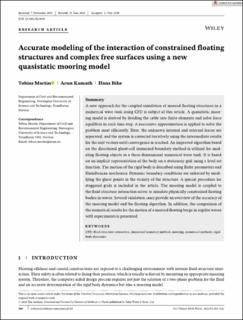| dc.contributor.author | Martin, Tobias | |
| dc.contributor.author | Kamath, Arun | |
| dc.contributor.author | Bihs, Hans | |
| dc.date.accessioned | 2021-10-21T08:31:33Z | |
| dc.date.available | 2021-10-21T08:31:33Z | |
| dc.date.created | 2020-08-29T11:31:09Z | |
| dc.date.issued | 2021 | |
| dc.identifier.citation | International Journal for Numerical Methods in Fluids. 2021, 93 (2), 504-526. | en_US |
| dc.identifier.issn | 0271-2091 | |
| dc.identifier.uri | https://hdl.handle.net/11250/2824394 | |
| dc.description.abstract | A new approach for the coupled simulation of moored floating structures in a numerical wave tank using CFD is subject of this article. A quasistatic mooring model is derived by dividing the cable into finite elements and solve force equilibria in each time step. A successive approximation is applied to solve the problem most efficiently. Here, the unknown internal and external forces are separated, and the system is corrected iteratively using the intermediate results for the unit vectors until convergence is reached. An improved algorithm based on the directional ghost-cell immersed boundary method is utilized for modeling floating objects in a three-dimensional numerical wave tank. It is based on an implicit representation of the body on a stationary grid using a level set function. The motion of the rigid body is described using Euler parameters and Hamiltonian mechanics. Dynamic boundary conditions are enforced by modifying the ghost points in the vicinity of the structure. A special procedure for staggered grids is included in the article. The mooring model is coupled to the fluid-structure interaction solver to simulate physically constrained floating bodies in waves. Several validation cases provide an overview of the accuracy of the mooring model and the floating algorithm. In addition, the comparison of the numerical results for the motion of a moored floating barge in regular waves with experiments is presented. | en_US |
| dc.language.iso | eng | en_US |
| dc.publisher | John Wiley & Sons Ltd. | en_US |
| dc.rights | Navngivelse 4.0 Internasjonal | * |
| dc.rights.uri | http://creativecommons.org/licenses/by/4.0/deed.no | * |
| dc.title | Accurate modelling of the interaction of constrained floating structures and complex free surfaces using a new quasi-static mooring model | en_US |
| dc.type | Peer reviewed | en_US |
| dc.type | Journal article | en_US |
| dc.description.version | publishedVersion | en_US |
| dc.source.pagenumber | 504-526 | en_US |
| dc.source.volume | 93 | en_US |
| dc.source.journal | International Journal for Numerical Methods in Fluids | en_US |
| dc.source.issue | 2 | en_US |
| dc.identifier.doi | 10.1002/fld.4894 | |
| dc.identifier.cristin | 1825885 | |
| dc.relation.project | Norges forskningsråd: 267981 | en_US |
| dc.relation.project | Notur/NorStore: NN2620K | en_US |
| cristin.ispublished | true | |
| cristin.fulltext | postprint | |
| cristin.qualitycode | 1 | |

